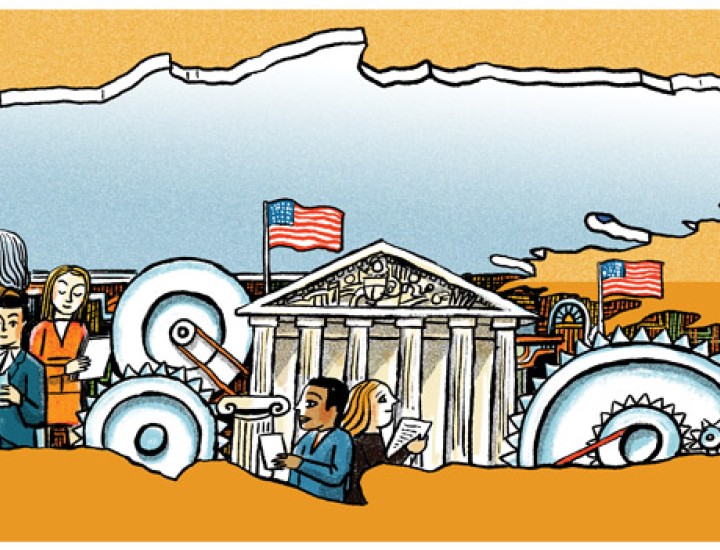With Supreme Court punting on gerrymandering, states must act

This article was originally published on June 22, 2018 by The Hill
On Monday, the Supreme Court opted not to address the substantive issues surrounding extreme partisan gerrymandering. This result is disappointing for those, like me, who hoped the court would rule that drawing districts for primarily partisan purposes could be unconstitutional. Now, the onus for action is on the states to stop gerrymandering for political purposes and to end its destructive impact on our democracy. The time to act is now — before new districts must be drawn following the 2020 census.
As citizens we should all care deeply about fair elections. They are critical to the survival of our democracy. Gerrymandering for political purposes distorts our democracy by crafting election districts that reward hyper-partisan candidates at the expense of candidates who must listen to all voters to get elected. If you live in a gerrymandered district and you are an unaffiliated voter or a member of a political party that is different than the one favored by gerrymandered district lines, most often your vote does not matter to the outcome of who gets elected. The election of your representative is determined in a party primary in which you likely cannot participate.
Further, the person elected to represent you is accountable only to members of the his/her party and does not really have to listen to your concerns. The voices of all the people are not heard, and more and more voters become disengaged from the election process. Our national dialogue suffers and gridlock in Congress and state legislatures is exacerbated. The results undermine faith in our democratic system of government and have made it nearly impossible for our government to solve the many big problems we are facing.
Yet, in spite of the risks posed by partisan gerrymandering, it is both unlikely and unwise for the courts to prescribe exactly how states must draw their districts. Instead, guidance from the courts will at most define approved methods or tests for determining whether extreme partisanship entered the redistricting process and, if so, order that districts be redrawn. Since passage of the Voting Rights Act, redistricting has been the subject of constant litigation, creating great uncertainty for voters and politicians, and costing taxpayers significant amounts of money that is needed to address other problems.
This week the high Court sent the case before it from Wisconsin back to the lower court to allow the parties to address issues of whether the parties bringing the case were harmed such that they had standing to challenge the district lines. The Maryland case, also before the Court, was sent back as well to the lower court without any decision on the merits of the claims. Rucho v. Common Cause, a similar case out of my home state of North Carolina, is still before the Supreme Court and could be heard during the Supreme Court’s next term.
But even if the Court rules on the North Carolina case and decides to implement a strict legal test to assess whether gerrymandering directly injures the voting power of voters in a particular district, solving the partisan redistricting problem will still require state-led reform.
In light of Monday’s ruling, states should take the initiative to adopt nonpartisan processes for drawing election districts. Such reform efforts aren’t just pie-in-the-sky good government idealism. By putting in place clear standards, rules, and criteria for how district lines are drawn, partisanship can be effectively minimized. What is important is that map drawers not consider partisan registration data, voting history data, or any other “proxy” data that indicates how citizens are likely to vote. Districts resulting from such processes are likely to be more competitive: thus, politicians must appeal to all voters to get elected, and they are rewarded for solving problems and not for partisan rhetoric and refusal to compromise.
Voters across the country and across the aisle support non-partisan redistricting. A number of states have already implemented non-partisan processes to establish election districts. Many are well on our way to making it happen. New 2018 ballot initiative efforts are advancing in Michigan, Utah, Missouri, and Arkansas, and elsewhere. Action is more complicated in states where citizen ballot initiatives are not allowed. But that doesn’t mean the effort is futile!
In North Carolina, we are well underway in our effort to push the state legislature, the General Assembly, to act. I serve as the co-chair of North Carolinians for Redistricting Reform, and our strategy is to rally North Carolinians to urge the General Assembly to put a state Constitutional amendment on the ballot for voters to decide if they want a new, non-partisan process for drawing the districts in which their representatives are elected instead of the increasingly partisan process.
In the absence of a ruling from the Supreme Court and ahead of the 2020 redistricting cycle, now is the time for states to act. Action is needed to reengage voters, and to protect and preserve our democracy.

